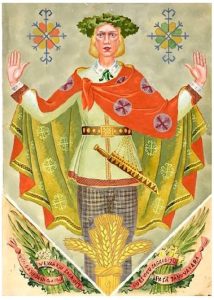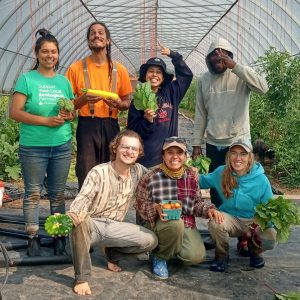Summer Solstice, A Latvian Tradition
THE FESTIVAL OF JĀŅI: A CELEBRATION OF THE SUMMER SOLSTICE
by Sean McLaughlin
 The Latvian Midsummer festival of Jāņi is quite complex with many prescribed rituals and activities leading up to the Eve of Jāņi. The days around the festival that celebrate the longest light of the year are considered magical, and nature itself is viewed as being at its pinnacle of growth. With the triumph of the longest light, it is a critical time to gather medicinal herbs, plants for dyes, and to thank nature for its abundance.
The Latvian Midsummer festival of Jāņi is quite complex with many prescribed rituals and activities leading up to the Eve of Jāņi. The days around the festival that celebrate the longest light of the year are considered magical, and nature itself is viewed as being at its pinnacle of growth. With the triumph of the longest light, it is a critical time to gather medicinal herbs, plants for dyes, and to thank nature for its abundance.
During the time of the festival the very power of nature is used as personal adornment, that is, the crowning of the head with field flowers, grasses, and leaves, and the traditional “greening” of the homestead with doors, windows, thresholds, and tables ornamented with foliage.
The Guest of this festival is the Son of God, Jānis, who, in oral tradition, is described as a tall, handsome man, beautifully dressed, who rides over the Hill of the Sun to join his “children,” the participants of the festival, on a large horse. On his head, he wears an abundant crown of oak leaves.
Accompanying Jānis, as is proper for a festival that celebrates fertility, is his exceptionally beautiful wife, ornamented with field flowers and clovers, as well as their many divine children.
Dievadēls Jānis needs a strong horse, for there is no specific location for the gatherings that occur on the Eve of Jāņi. In older times tar and wood would be set in buckets, lit, and raised on poles, and great bonfires would be set on sacred hills or regional holy areas, and their light would call the Children of Jānis to come from their homes to the gathering as dusk falls.
Fire is still burned on cardinal points throughout every region in Latvia, just as it is burned wherever community gathers. But Jānis will appear anywhere where there will be fire, traditional Jāņu songs to welcome him, and beer and special cheese to consume. All four of these mandatory components have to last through the entire night.
It’s incredibly difficult to make a summation of the many rituals and activities that precede Jāņi and are part of Jāņu Eve.
I was taught that one should sing while entering the celebration, and that song should be the main way to communicate throughout the long night. One should really try this. It’s quite fun. Even if you only sing the traditional refrain of līgo.
Music is also critically important, for traditionally, when the festival hosts have finished sets of sung “invitations” to Jānis and his family, the old way of welcoming the arriving Guests is with drums and horns. Can you imagine what it was like to hear the horns and drums sounding from point to point, as fire blossomed in all directions at the start of Jāņu twilight, calling his other children (participants of the festival) forth?
One of my favorite things to do during Jāņi, because it is so easy and accessible, is the gathering of long grasses, which are then placed in a flat layer on a celebration table. When the grasses are set and arranged they’re covered with a beautiful tablecloth.
In our family, we decorate the indoor table where we gather throughout most of the year and use a special woven tablecloth of the Sun to cover the grasses. Such an act brings abundant nature inside where we acknowledge it as one of the principal foundations of our home. Even as we ready ourselves to go outside, to move in the darkness towards the light, and become in community, Jāņa Children.
Adorned, as he and his wife are adorned… dancing, singing, feasting, as he, his wife and children, dance, sing, and feast. Giving thanks.
PICTURED: The Latvian Son of God Jānis by Ansis Cīrulis, 1931.
Baltic Imports. For more on Baltic Folk Traditions and Amber, please visit
facebook.com/balticimports pinterest.com/balticimports
Text by Sean McLaughlin



